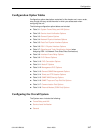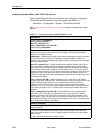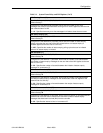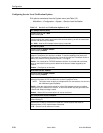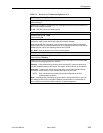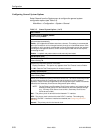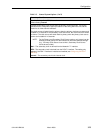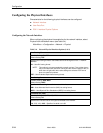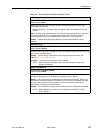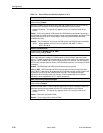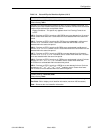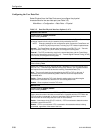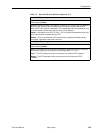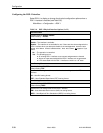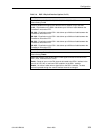
Configuration
3-25
9124-A2-LB20-00
March 2000
Table 3-4. Network Physical Interface Options (2 of 4)
Bit Stuffing
Possible Settings: 62411, Disable
Default Setting: 62411
Determines the type of bit insertion to provide ones density requirements for data
transmitted to the network.
Display Conditions – This option does not appear when Line Coding Format is set
to B8ZS.
62411 – Inserts a one in the data after 15 consecutive zeros are received or the density
of ones falls below 12.5%. This setting complies with AT&T TR 62411, but is not
recommended for frame relay data because it inserts errors in the data traffic.
Disable – Disables bit stuffing. Ones density is not enforced on data sent to the
network.
Transmit Timing
Possible Settings: System, Interface
Default Setting: System
Allows transmit timing to be selected from either the system master clock source or from
the currently selected interface.
System – Transmit timing is derived from the current system clock source (see
Table 3-3, General System Options).
Interface – Transmit timing is derived from this interface.
NOTE: When Interface is configured, the clock must be synchronized to the
system clock source.
Network Initiated LLB
Possible Settings: Enable, Disable
Default Setting: Enable
Allows the initiation and termination of the line loopback (LLB) to be controlled by the
receipt of LLB-Actuate and LLB-Release commands from the network.
Enable – LLB is controlled by LLB-Actuate and LLB-Release commands. Receiving a
LLB-Actuate command causes the FrameSaver unit to enter a line loopback (provided
an LLB can be performed in the FrameSaver unit’s current state). Receiving an
LLB-Release command terminates the LLB.
Disable – The FrameSaver unit ignores the LLB-Actuate and LLB-Release commands.
NOTE: When disabled, the system is not in compliance with ANSI T1.403 or
AT&T TR 62411.



